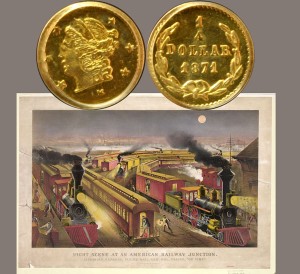Today, the California Fractional Gold Coin remembers a time when $20,000,000 in gold traveled via registered mail from San Francisco, arriving in New York on August 9, 1892.
Three articles from magazines of that era provide more details:
=====
Railway and Engineering Journal of September 1892:
The most valuable through train which ever crossed the continent was one which arrived in New York on the morning of August 9, carrying $20,000,000 in gold sent from the sub-treasury in San Francisco to that in New York.
It consisted of four baggage cars carrying the gold and a sleeping car for the guards who accompanied it.
It was in charge of officials of the Post-Office Department, and was well guarded throughout its journey; but no attempt was made to interfere with the safe transit of the treasure.
The train made an exceptionally fast run, leaving San Francisco at 6.30 p.m. on August 4, and reaching New York at 10.46 a.m. on August 9; the total time was thus 4 days, 13 hours, 16 minutes, or less than an hour more than the time made by the fastest continuous through train on record.
The Railroad Gazette of August 12, 1892:
The United States Post Office Department has, during the past week, transported $20,000,000 in gold coin from San Francisco to New York in a single shipment, which came on a special fast mail train over the Southern Pacific, the Union Pacific, the Chicago, Burlington & Quincy, the Lake Shore & Michigan Southern and the New York Central & Hudson River.
This money was transferred for the Treasury Department from the Sub-Treasury in San Francisco to the Sub-Treasury in New York, and the Post Office Department handled the packages under the regulations governing registered letters.
The train consisted of four express cars, carrying about 10 tons each, and one passenger car.
Each of the four cars was in charge of a division superintendent of the Railway Mail Service with nine assistants, all heavily armed, and the same men accompanied the train throughout.
The time through was 4 days, 13 hours and 16 minutes.
The train was scheduled as the second section of the regular fast mail, leaving San Francisco at 6.30 on the evening of Aug. 4.
It lost some time, but this was made up during the latter part of the journey, the run from Buffalo to New York being made in 9 hours and 20 minutes. which is about the same time as that made by the east-bound Empire State Express.
The train arrived in New York at 10:46 on the morning of Aug. 9, and the guards, though vigilant, did not manifest such excessive caution as to justify the sensational accounts of some of the Western reporters.
The gold was in boxes of $40,000 each. weighing about 160 lbs., and 125 of them were loaded in a car.
A number of guards rode in the car next behind the engine and kept their eyes constantly on the cab and its occupants.
From San Francisco to Ogden the guards (there were over fifty in all) ate in the cars, but for the remainder of the journey they went out at meal time, half of them at a time.
Probably the greatest danger to which this train was subject was the possibility of a derailment, accidental or otherwise, which might injure a majority of the guards; but it appears that this was not regarded as a serious matter, as the train traveled at high speed both night and day.
The Engineering and Mining Journal of August 20, 1892:
The Large Shipment of Gold from San Francisco to Washington.—
The largest shipment of gold coin probably ever made was the recent transfer of $20,000,000 from the sub-treasury in San Francisco to Washington via New York.
It was hauled by the railroads under their regular mail contracts, and came through as registered mail.
The Assistant Treasurer at San Francisco had 500 boxes made especially for the shipment at a cost of $1,000.
Then there were the personal expenses of fifty-one men who went to San Francisco and guarded the treasure on its way East.
These were the principal expenditures.
The laborers at the mint at San Francisco were pressed into service to pack and load the money, the regular employees of the railway mail service guarded it, the arms which the guards carried were taken from the arsenal, and the mail wagons of the Post-Office Department were used to carry the boxes to and from the cars.
The estimated cost is placed at $3,500.
The lowest bid the Treasury Department could obtain from an express company for hauling the money was $3 per $1,000, or $60,000.
This, of course, would have included the risk of loss in transit by accident or theft.
The Wells, Fargo & Co., which controls all the territory west of the Missouri, made this rate.
=====
The California Fractional Gold Coin shows with an image of an American railway junction, including mail trains, circa late 1800s.
